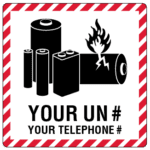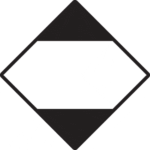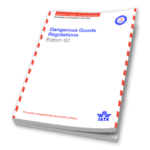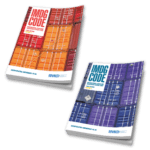The year 2021 is well underway, and most of us are feeling that, at least from a regulatory viewpoint, things are starting to go back to normal. Regulators are talking about amendments, new developments are being worked on (or are already here), and some changes that were long-awaited have finally occurred. So, let’s take a quick look at five things that you should address now, or in the very near future, if you work with the transportation of dangerous goods.
COVID-19 Extensions Are Ending
During the height of the COVID-19 pandemic, both the US and Canadian governments gave extensions for training recertification. Obviously, the typical face-to-face method of delivering training just wasn’t appropriate for the new reality. So, the authorities allowed training that was due to expire in the early days of the pandemic to remain valid. However, there are alternatives, such as computer-based training and live webinars that can be delivered safely. Both the US Department of Transportation (DOT) and Transport Canada have let their training extensions lapse. If your training is expired, your employer will need to come up with a way to get you retrained, or at least updated for any new requirements, and recertified.
Another provision made by both DOT and Transport Canada for COVID was the relief for shipping packages of hand sanitizer that were over the amount allowed as limited quantity (usually, that’s 1 Litre per inner container). Due to a shortage of packaging and supplies, the two governments created options for shipping larger containers (say, 5 Litre bottles or 20 Litre pails) with reduced hazard communication and packaging requirements. However, the DOT arrangement has expired. Transport Canada will allow the use of their special permit until the end of 2021 but will probably not extend it further, as hand sanitizer stocks appear to have stabilized.
Change of Markings for Limited Quantities and Consumer Commodities
Speaking of limited quantities, both the US regulations of “Title 49 of the Code of Regulations” (49 CFR) and Canada’s “Transportation of Dangerous Goods Regulations” (TDG) have finally implemented the changes started several years ago. These will help put the US and Canada on the same footing as international regulations, such as the IMDG Code.
On the DOT side, the Limited Quantity diamond has been made mandatory for shipments of limited quantities. Also, the “CONSUMER COMMODITY ORM-D” marking will be phased out for ground shipments. TDG, section 1.17 has been amended to remove the option for marking limited quantities with the words “Limited Quantity,” “LTD. QTY.” or “Consumer Commodity” (or French equivalents). Instead, the Limited Quantity diamond is now mandatory. Note that Mexico has also updated its standard on limited quantities to reflect the current UN marking.
These changes do not affect the description found in the IATA Dangerous Goods Regulations of ID8000, Consumer Commodity, Class 9. This is a special description used for mixed small containers of consumer products and will still be considered a valid description for air transport.
IMO Delays Implementation of IMDG Code
COVID-19 changed a lot of plans. Vacations, conferences, schooling. It even threw off the International Maritime Organization and their plan to bring out the newest International Maritime Dangerous Goods Code (IMDG Code) at its normal schedule in late 2020. Instead, it was delayed until January of 2021. Normally, a new version of the IMDG Code may be used starting January 1 of the upcoming year, but since the document itself was published behind schedule, this implementation date has been pushed back to June 1, 2021. The “2020 edition” then doesn’t become mandatory until June 1, 2022 – only a few months before the next edition is released.
Air Regulations and Transport Canada Move towards “Competency-Based Training”
So, you think you have your corporate training under control? Well, watch out because a new concept for training is looming on the horizon – “competency-based training.” In general terms, competency-based training requires the training provider to break the topic of training down into specific “competencies” or abilities, and to focus on ensuring that the worker has mastered those particular competencies.
Competency-based training is required by ICAO (International Civil Aviation Organization) and IATA (International Air Transport Association) for “operators” – that is, airlines and freight forwarders. While the standards in the US and Canada for legal enforcement do not yet address this type of training, Transport Canada is planning on introducing a proposed amendment to TDG later this year that would eventually make competency-based training a requirement for all modes in Canada. The requirements can be found in the standard CGSB-192.3-2020 “Transportation of dangerous goods training, assessment and competency,” published by the Canadian General Standards Board.
This standard will require much more preliminary work in establishing what competencies workers need to have mastered and how to prove they’ve mastered them. Canadian shippers and carriers should start to figure out how this will work in their facilities as soon as feasible. One way is to use training specialists to help you with the initial assessment of training needs.
Lithium Battery Changes
As always, lithium batteries pose a moving target as regulations are guided by new developments in battery safety. Important considerations for the start of 2021 include:
- New sizing for Lithium Battery Handling Mark – The UN Recommendations on the Transport of Dangerous Goods, as well as ICAO, IATA and IMDG, have reduced the minimum size of the Lithium Battery Handling Mark to 100 mm per side (from 120 mm by 110 mm), allowing it to have the same dimensions as a typical hazard class label. This will increase the chance of labels fitting on small packages. This smaller size is not currently in 49 CFR or TDG (although it will be incorporated in their upcoming harmonization amendments). However, TDG accepts safety marks that meet UN standards, and DOT has indicated that they will not issue any enforcement over this size of mark until the harmonization is completed.
- New IATA packaging requirements for equipment containing batteries – ICAO/IATA Packing Instructions 967 and 970, for lithium batteries contained in equipment have been amended to add two extra requirements. Equipment containing lithium cells or batteries must be secured against movement within the outer packaging, and where multiple pieces of equipment are packed in one outer packaging, the equipment must be protected against contact with other equipment so as to prevent damage. This is in reaction to a number of accidents involving multiple pieces of equipment such as laptops placed in one package without dividers.
- Battery testing report – The UN Recommendations have begun to require manufacturers and distributors of lithium batteries to make the testing summary on the battery design available to down-stream customers. Of course, the Recommendations aren’t binding. But the DOT has amended 49 CFR to require “each manufacturer and summary available (see 49 CFR section 173.185(a)(3)). While this section doesn’t describe in detail subsequent distributor” of lithium cells or batteries manufactured after 2007 to have a testing what “available” means, the goal is for downstream shippers and users to be able to verify that batteries have met the testing requirements of sub-section 38.3 of the UN Manual of Tests and Criteria. So, if you ship lithium batteries (or even lithium battery-powered equipment in the US), get your paperwork in order. On the other hand, Transport Canada has not yet made this a requirement, although it’s likely to be incorporated in upcoming amendments. Even if it’s not a legal requirement, though, Canadians should expect to field requests for such summaries. You’ll keep your customers happy if you can provide it, even if it’s not enforced by Transport Canada.
So, shake off the dust; it’s time to start reviewing your procedures (if you haven’t already) and preparing for a game of “catch up” in the upcoming year as regulators try to get back onto something like a normal schedule. Whether you ship limited quantities or lithium batteries, there’s always something new. If you have questions regarding any of these topics, or other changes that you see coming your way, contact ICC Compliance Center here at 888-442-9628 (U.S.) or 888-977-4834 (Canada), and ask for one of our Regulatory Experts. We can help you determine what adjustments you need to make.
Sources:
Title 49, Code of Federal Regulations, Hazardous Materials Regulations
Transportation of Dangerous Goods Regulations
Temporary certificate TU 0752.3: Hand sanitizer
Canadian General Standards Board CGSB-192.3-2020
“Transporting Lithium Batteries,” by Pipelines and Hazardous Materials Safety Administration
Stay up to date and sign up for our newsletter!
We have all the products, services and training you need to ensure your staff is properly trained and informed.
 Lithium Battery Pictogram, Custom, 100×100 mm, Gloss Paper, 500/Roll |
 Limited Quantity Label, 4″ x 4″, Gloss Paper, 500/Roll |
 IATA Publications |
 IMDG Publications |







 ICC USA
ICC USA ICC Canada
ICC Canada